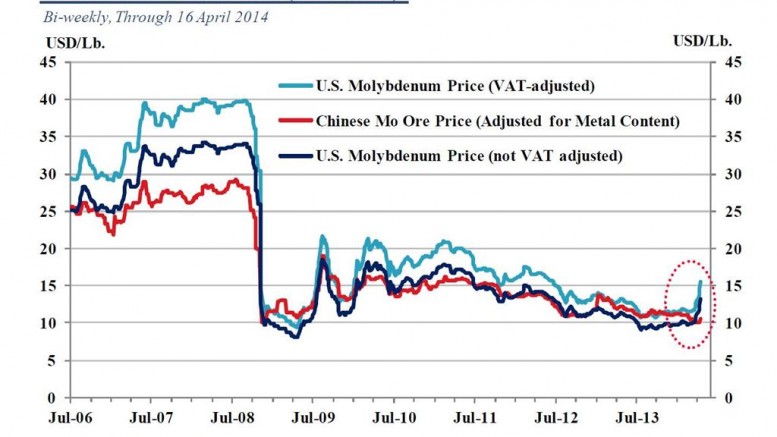Molybdenum prices in Europe have risen rapidly after the World Trade Organization (WTO) confirmed that the export duties and quotas imposed by China on molybdenum are incompatible with its WTO obligations. This report concludes a dispute initiated in March 2012 when the European Union, Japan and the U.S. filed a formal request with the WTO for consultation with China over its restrictions on exports of rare earths, tungsten and molybdenum.
As of April 16, molybdenum prices have jumped nearly 31% to US$13.20 per lb. moly contained (basis Metal Bulletin) since the March 26 report. Prices in China meanwhile are up just 4.2% over this same period.
China has yet to announce a formal response to the WTO’s ruling. There is a possibility that China may remove the export duties on some molybdenum products as a concession in order to keep duties and quotas on tungsten and rare earths.
As part of a January 2013 response to a WTO ruling on a separate case regarding export taxes on silicon metal, silicon carbide, manganese, magnesium, zinc, bauxite, coking coal, fluorspar and yellow phosphorus, the Chinese government removed the 20% duty on the export of electrolytic manganese metal (EMM), as well as some of the duties of other metals.
China may be pushed to reduce or remove the current duties on molybdenum product exports, as had been the case with the EMM export duty. EMM exports rose strongly in response, possibly due to exporters officially reporting their goods at customs rather than smuggling them out of the country. Official EMM prices also fell.
The case for molybdenum differs from EMM, however, as it is a metal under consideration for a national resource classification. Official regulations for the molybdenum industry could be shifted to the Ministry of Land and Resources, which also manages tungsten and rare earths.
There also are government concerns with regard to the price stability of these specialty metal markets. In the past, the Chinese government has adamantly opposed lowering prices for its raw material exports, particularly in instances related to price competition by a large number of domestic exporters.
That said, there have been major producers voicing support for lowering trade barriers as they seek to expand sales internationally in response to the lack of orders for the surplus metal in the domestic market.
In 2013 China’s domestic molybdenum prices traded at premium (~14.3%) to Western world prices, so there was no incentive to export molybdenum. This trend remained in place until the run-up in Western world prices in the first two weeks in April. According to Metal Bulletin, Chinese prices held on average a US91¢ — or 9.2% premium — over the Western world’s price between Jan. 1 and March 21.
Since the ruling, however, Western world prices are at a premium to China. As of April 16, Metal Bulletin reported Western world molybdenum at US$13.20 and Chinese molybdenum at roughly US$10.55, a premium of $2.65, or 20%.
Obviously both markets need time to process the news. However, Western world prices have risen to levels that will likely encourage exports from China in the near-term. Even with current duties in place on various molybdenum products, some of which are as high as 20%, arbitrage opportunities still exist for Chinese exporters. The current sizable price differential may act as an incentive for the Chinese government to keep present taxes in place to help disincentivize exports of their national molybdenum resource.
Molybdenum prices in the Western world are being bolstered by robust demand, which has been strengthening in regions outside of China. This is most notable in Europe and South Korea, which have seen a strong rebound in steel production during first two months of 2014, growing 6.5% and 3.9% year-on-year, respectively, compared to -2.2% and -4.8% in all of 2013. Crude steel production is also strengthening in Japan, with output rising 3.8% in the first two months of 2014 from year-ago levels.
— Catherine Virga is the director of research at commodities research and consulting firm CPM Group in New York City. She is lead author of CPM Group’s “Molybdenum Market Outlook 2013,” a major long-term report on molybdenum released in December 2013. For more information on CPM Group’s report, please contact Matt Taub at mtaub@cpmgroup.com, call 1-212-785-8320 or visit www.cpmgroup.com.


Be the first to comment on "Metals Commentary: What’s behind molybdenum’s dramatic price response"